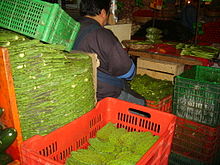- Nopal
-
Nopales (from the Nahuatl word nōpalli for the pads) are a vegetable made from the young cladode (pad) segments of prickly pear, carefully peeled to remove the spines. These fleshy pads are flat and about hand-sized. They can be purple or green. They are particularly common in their native Mexico, where the plant is eaten commonly and regularly forms part of a variety of Mexican cuisine dishes. Farmed nopales are most often of the species Opuntia ficus-indica, although the pads of almost all Opuntia species are edible.
Nopales are generally sold fresh in Mexico. In more recent years bottled, or canned versions are available mostly for export. Less often dried versions are available. Used to prepare nopalitos, they have a light, slightly tart flavor, like green beans, and a crisp, mucilaginous texture. In most recipes the mucilaginous liquid they contain is included in the cooking. They are at their most tender and juicy in the spring.[1]
Though Nopales are most commonly used in Mexican cuisine in dishes such as huevos con nopales (eggs with nopal), "carne con nopales" (meat with nopal), "tacos de nopales", or simply on their own or in salads with Panela Cheese. Nopales have also grown to be an important ingredient in New Mexican cuisine[2] and in Tejano culture (Texas).
Contents
Health benefits
Nopales are very rich in insoluble and especially soluble dietary fiber. They are also rich in vitamins (especially vitamin A, vitamin C, and vitamin K, but also riboflavin and vitamin B6) and minerals (especially magnesium, potassium, and manganese, but also iron and copper). Nopales have a high calcium content, but the nutrient is not biologically available because it is present as calcium oxalate, which is neither highly soluble nor easily absorbed through the intestinal wall.[3] Addition of nopales also reduces the glycemic effect of a mixed meal.[4] Nopales are low carbohydrate and may help in the treatment of diabetes.[5]
Economic value
A nopales merchant at his stand in the Merced market of Mexico City
According to Reuters, some 10,000 farmers cultivate nopal in Mexico, producing around $150 million worth of it each year. Detection of the cactus-eating moth Cactoblastis cactorum in Mexico in 2006 caused anxiety among the country's phytosanitary authorities, as this insect can be potentially devastating for the cactus industry.[6]
Lifecycle
See also: Biological life cycleEdible Leaf Cycle
References
- ^ Aliza Green, Field Guide to Produce, Quirk Productions, 2004, p 214-215, ISBN 1-931686-07-6
- ^ Thorny Mexican food staple gains fame as folk cure by Frank Jack Daniel, Reuters (Mon Apr 16, 2007 10:34 AM ET)
- ^ Mcconn, Michele; Nakata, Paul (February 2004). "Oxalate Reduces Calcium Availability in the Pads of the Prickly Pear Cactus Through Formation of Calcium Oxalate Crystals". Journal of Agricultural and Food Chemistry 52 (5): 1371–1374. doi:10.1021/jf035332c. PMID 14995148. http://www.ars.usda.gov/research/publications/publications.htm?SEQ_NO_115=161211. Retrieved 2006-08-10.
- ^ M Bacardi-Gascon, D Duenas-Mena and A Jimenez-Cruz (May 2007). "Lowering effect on postprandial glycemic response of nopales added to Mexican breakfasts". Diabetes Care 30 (5): 1264–1265. doi:10.2337/dc06-2506. PMID 17325260. http://care.diabetesjournals.org/cgi/content/extract/30/5/1264.
- ^ Use Of The Latin Food Staple Nopales: The Prickly Pear Cactus
- ^ Cactus-eating moth threatens favorite Mexican food (Mon Feb 19, 2007)
- http://www.hort.purdue.edu/newcrop/proceedings1996/V3-416.html#Cactus%20Pear
- http://www.reuters.com/article/healthNews/idUSN1323115520070416 "Thorny Mexican food staple gains fame as folk cure" (Mon Apr 16, 2007)
External sources
Videos
Recipes
Categories:- Stem vegetables
- Natural history of Mesoamerica
- Mexican cuisine
- Mexican ingredients
- Aztec society
- Diabetes
- New Mexican cuisine
Wikimedia Foundation. 2010.









